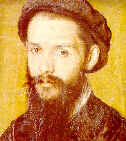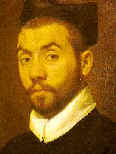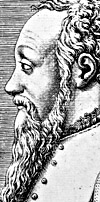

Originally from the 1911 Encyclopedia Britannica
Clément Marot, French poet, was born at Cahors, the capital of the province of Quercy, some time during the winter of the year 1496-1497.
His father, Jean Marot (c. 1463-1523), whose more correct name appears to have been des Mares, Marais or Marets, was a Norman of the neighbourhood of Caen. Jean was himself a poet of considerable merit, and held the post of escripvain (apparently uniting the duties of poet laureate and historiographer) to Anne of Brittany . He had however resided in Cahors for a considerable time, and was twice married there, his second wife being the mother of Clement. The boy was "brought into France"--it is his own expression, and is not unnoteworthy as showing the strict sense in which that term was still used at the beginning of the 16th century --in 1506, and he appears to have been educated at the University of Paris, and to have then begun the study of law. But, whereas most other poets have had to cultivate poetry against their father's will, Jean Marot took great pains to instruct his son in the fashionable forms of verse-making, which indeed required not a little instruction.
It was the palmy time of the rhétoriqueurs, poets who combined stilted and pedantic language with an obstinate adherence to the allegorical manner of the 15th century and to the most complicated and artificial forms of the ballade and the rondeau. Clément himself practised with diligence this poetry (which he was to do more than any other man to overthrow), and he has left panegyrics of its coryphaeus Guillaume Cretin, the supposed original of the Raminagrobis of Rabelais, while he translated Virgil 's first eclogue in 1512. Nor did he long continue even a nominal devotion to law. He became page to Nicolas de Neuville, seigneur de Villeroy, and this opened to him the way to court life. Besides this, his father's interest must have been not inconsiderable, and the house of Valois, which was about to hold the throne of France for the greater part of a century, was devoted to letters.
 As early as 1514, before the accession of Fran¸ois I, Clément presented to him his Judgment of Minos, and shortly afterwards he was either styled or styled himself facteur (goet) de la reine to Queen Claude. In 1519 he was attached to the suite of Marguerite d'Angoulême, the king's sister, who was for many years to be the mainstay not only of him but of almost all French men of letters. He was also a great favourite of Fran¸ois himself, attended the Field of the Cloth of Gold in 1520, and duly celebrated it in verse. Next year he was at the camp in Flanders, and writes of the horrors of war.
As early as 1514, before the accession of Fran¸ois I, Clément presented to him his Judgment of Minos, and shortly afterwards he was either styled or styled himself facteur (goet) de la reine to Queen Claude. In 1519 he was attached to the suite of Marguerite d'Angoulême, the king's sister, who was for many years to be the mainstay not only of him but of almost all French men of letters. He was also a great favourite of Fran¸ois himself, attended the Field of the Cloth of Gold in 1520, and duly celebrated it in verse. Next year he was at the camp in Flanders, and writes of the horrors of war.
It is certain that Marot, like most of Marguerite's literary court, and perhaps more than most of them, was greatly attracted by her gracious ways, her unfailing kindness, and her admirable intellectual accomplishments, but there is not the slightest ground for thinking that his attachment was other than platonic. It is, however, evident that at this time either sentiment or matured critical judgment effected a great change in his style, a change which was wholly for the better. At the same time he celebrates a certain Diane, whom it has been sought to identify with Diane de Poitiers . There is nothing to support this idea and much against it, for it was an almost invariable habit of the poets of the 16th century, when the mistresses whom they celebrated were flesh and blood at all (which was not always the case), to celebrate them under pseudonyms.
In the same year, 1524, Marot accompanied Fran¸ois on his disastrous Italian campaign. He was wounded and taken at Pavia, but soon released, and he was back again at Paris by the beginning of 1525. His luck had, however, turned. Marguerite for intellectual reasons, and her brother for political, had hitherto favoured the double movement of Aufklärung, partly humanist, partly Reforming, which distinguished the beginning of the century. Formidable opposition to both forms of innovation, however, now began to be manifested, and Marot, who was at no time particularly prudent, was arrested on a charge of heresy and lodged in the Châtelet, February 1526. But this was only a foretaste of the coming trouble, and a friendly prelate, acting for Marguerite, extricated him from his durance before Easter. The imprisonment gave him occasion to write a vigorous poem on it entitled Enfer, which was afterwards imitated by his luckless friend Etienne Dolet. His father died about this time, and Marot seems to have been appointed to the place which Jean had latterly enjoyed, that of valet de chambre to the king. He was certainly a member of the royal household in 1528 with a stipend of 250 livres, besides which he had inherited property in Quercy. In 1530, probably, he married. Next year he was again in trouble, not it is said for heresy, but for attempting to rescue a prisoner, and was again delivered; this time the king and queen of Navarre seem to have bailed him themselves.
In 1532 he published (it had perhaps appeared three years earlier), under the title of Adolescence Clémentine, a title the characteristic grace of which excuses its slight savour of affectation, the first printed collection of his works, which was very popular and was frequently reprinted with additions. Dolet's edition of 1538 is believed to be the most authoritative. Unfortunately, however, the poet's enemies were by no means discouraged by their previous ill-success, and the political situation was very unfavourable to the Reforming party. In 1535 Marot was implicated in the affair of "The Placards," and this time he was advised or thought it best to fly. He passed through Beam, and then made his way to Renée, duchess of Ferrara, a supporter of the French reformers as steadfast as her aunt Marguerite, and even more efficacious, because her dominions were out of France. At Ferrara he wrote a good deal, his work there including his celebrated Blasons (a descriptive poem, improved upon medieval models), which set all the verse-writers of France imitating them. But the duchess Renée was not able to persuade her husband, Ercole d'Este, to share her views, and Marot had to quit the city.

The blason was defined by Thomas Sibilet as a perpetual praise or continuous vituperation of its subject. The blasons of Marot's followers were printed in 1543 with the title of Blasons anatomiques du corps féminin.
He then went to Venice, but before very long the pope Paul III remonstrated with Fran¸ois I on the severity with which the Protestants were treated, and they were allowed to return to Paris on condition of recanting their errors. Marot returned with the rest, and abjured his heresy at Lyons. In 1539 Fran¸ois gave him a house and grounds in the suburbs.
It was at this time that his famous translations of the Psalms appeared. The merit of these has been sometimes denied, it is, however, considerable, and the powerful influence which the book exercised on contemporaries is not denied by anyone. The great persons of the court chose different pieces, each as his or her favourite. They were sung in court and city, and they are said, with exaggeration doubtless, but still with a basis of truth, to have done more than anything else to advance the cause of the Reformation in France. Indeed, the vernacular prose translations of the Scriptures were in that country of little merit or power, and the form of poetry was still preferred to prose, even for the most incongruous subjects.
At the same time Marot engaged in a curious literary quarrel characteristic of the time, with a bad poet named Sagon, who represented the reactionary Sorbonne. Half the verse-writers of France ranged themselves among the Marotiques or the Sagontiques, and a great deal of versified abuse was exchanged. The victory, as far as wit was concerned, rested with Marot, but his biographers are probably not fanciful in supposing that a certain amount of odium was created against him by the squabble, and that, as in Dolet's case, his subsequent misfortunes were not altogether unconnected with a too little governed tongue and pen.
The publication of the Psalms gave the Sorbonne a handle, and the book was condemned by that body. In 1543 it was evident that he could not rely on the protection of Francis. Marot accordingly fled to Geneva; but the stars were now decidedly against him. He had, like most of his friends, been at least as much of a freethinker as of a Protestant, and this was fatal to his reputation in the austere city of Calvin . He had again to fly, and made his way into Piedmont, and he died at Turin in the autumn of 1544.
In character Marot seems to have been a typical Frenchman of the old stamp, cheerful, good-humoured and amiable enough, but probably not very much disposed to elaborately moral life and conversation or to serious reflection. He has sometimes been charged with a want of independence of character; but it is fair to remember that in the middle ages men of letters naturally attached themselves as dependants to the great. Such scanty knowledge as we have of his relations with his equals is favourable to him. He certainly at one time quarrelled with Dolet, or at least wrote a violent epigram against him, for which there is no known cause. But, as Dolet quarrelled with almost every friend he ever had, and in two or three cases played them the shabbiest of tricks, the presumption is not against Marot in this matter. With other poets like Melin de Saint-Gelais and Brodeau, with prose writers like Rabelais and Bonaventure des Périers, he was always on excellent terms. And whatever may have been his personal weaknesses, his importance in the history of French literature is very great, and was long rather under than over-valued. Coming immediately before a great literary reform--that of the Pléiade --Marot suffered the drawbacks of his position; he was both eclipsed and decried by the partakers in that reform.
In the reaction against the Pléiade he recovered honour; but its restoration to virtual favour, a perfectly just restoration, again unjustly depressed him. Yet Marot is in no sense one of those writers of transition who are rightly obscured by those who come after them. He himself was a reformer, and a reformer on perfectly independent lines, and he carried his own reform as far as it would go. His early work was couched in the rhétoriqueur style, the distinguishing characteristics of which are elaborate metre and rhyme, allegoric matter and pedantic language. In his second stage he entirely emancipated himself from this, and became one of the easiest, least affected and most vernacular poets of France. In these points indeed he has, with the exception of La Fontaine, no rival, and the lighter verse-writers ever since have taken one or the other or both as model.
In his third period he lost a little of this flowing grace and ease, but acquired something in stateliness, while he certainly lost nothing in wit. Marot is the first poet who strikes readers of French as being distinctively modern. He is not so great a poet as Villon nor as some of his successors of the Pléiade, but he is much less antiquated than the first (whose works, as well as the Roman de la rose, it may be well to mention that he edited) and not so elaborately artificial as the second. Indeed if there be a fault to find with Marot, it is undoubtedly that in his gallant and successful effort to break up, supple, and liquefy the stiff forms and stiffer language of the 15th century, he made his poetry almost too vernacular and pedestrian. He has passion, and picturesqueness, but rarely; in his hands, and while the style Marotique was supreme, French poetry ran some risk of finding itself unequal to anything but graceful vers de société. But it is only fair to remember that for a century and more its best achievements, with rare exceptions, had been vers de société which were not graceful.
The most important early editions of Marot's oeuvres are those published at Lyons in 1538 and 1544. In the second of these the arrangement of his poems which has been accepted in later issues was first adopted. In 1596 an enlarged edition was edited by Francois Mizihre. Others of later date are those of N. Lenglet du Fresnoy (the Hague, 1731) and P Jannet (1868‹1872; new ed, 1873‹1876), on the whole the best, but there is a very good selection with a still better introduction by Charles d'Héricault, the joint editor of the Jannet edition in the larger Collection Gamier (no date). An elaborate edition by G Guiffrey remained incomplete, only vols. ii. and iii. (1875-1881) having been issued. For information about Marot himself see Notices biographiques des trois Marot, edited from the manuscript of Guillaume Colletet by G Guiffrey (1871); H Morley, Clement Marot, a study of Marot as a reformer; O Douen, Clement Marot et le psautier huguenot; the section concerning him in G Saintsbury 's The Early Renaissance (1901); and A Tilley, Literature of the French Renaissance, vol. i., ch. iv. (1904).